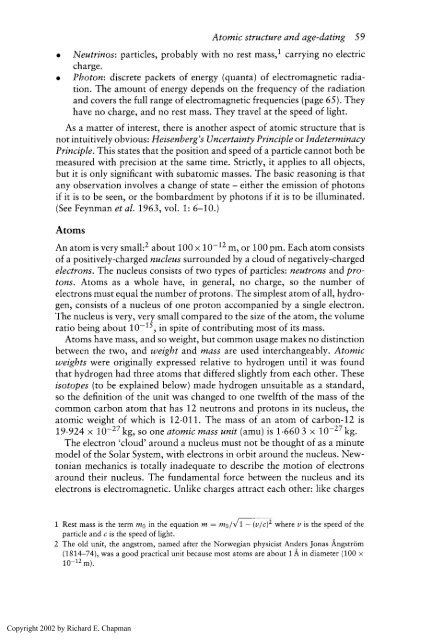Physics for Geologists, Second edition
Physics for Geologists, Second edition
Physics for Geologists, Second edition
Create successful ePaper yourself
Turn your PDF publications into a flip-book with our unique Google optimized e-Paper software.
Atomic structure and age-dating 59<br />
Neutrinos: particles, probably with no rest mass,l carrying no electric<br />
charge.<br />
Photon: discrete packets of energy (quanta) of electromagnetic radia-<br />
tion. The amount of energy depends on the frequency of the radiation<br />
and covers the full range of electromagnetic frequencies (page 65). They<br />
have no charge, and no rest mass. They travel at the speed of light.<br />
As a matter of interest, there is another aspect of atomic structure that is<br />
not intuitively obvious: Heisenberg's Uncertainty Principle or Indeterminacy<br />
Principle. This states that the position and speed of a particle cannot both be<br />
measured with precision at the same time. Strictly, it applies to all objects,<br />
but it is only significant with subatomic masses. The basic reasoning is that<br />
any observation involves a change of state - either the emission of photons<br />
if it is to be seen, or the bombardment by photons if it is to be illuminated.<br />
(See Feynman et al. 1963, vol. 1: 6-10.)<br />
Atoms<br />
An atom is very small:2 about 100 x 10-l2 m, or 100 pm. Each atom consists<br />
of a positively-charged nucleus surrounded by a cloud of negatively-charged<br />
electrons. The nucleus consists of two types of particles: neutrons and pro-<br />
tons. Atoms as a whole have, in general, no charge, so the number of<br />
electrons must equal the number of protons. The simplest atom of all, hydro-<br />
gen, consists of a nucleus of one proton accompanied by a single electron.<br />
The nucleus is very, very small compared to the size of the atom, the volume<br />
ratio being about 10-15, in spite of contributing most of its mass.<br />
Atoms have mass, and so weight, but common usage makes no distinction<br />
between the two, and weight and mass are used interchangeably. Atomic<br />
weights were originally expressed relative to hydrogen until it was found<br />
that hydrogen had three atoms that differed slightly from each other. These<br />
isotopes (to be explained below) made hydrogen unsuitable as a standard,<br />
so the definition of the unit was changed to one twelfth of the mass of the<br />
common carbon atom that has 12 neutrons and protons in its nucleus, the<br />
atomic weight of which is 12.011. The mass of an atom of carbon-12 is<br />
19.924 x kg, so one atomic mass unit (amu) is 1.660 3 x kg.<br />
The electron 'cloud' around a nucleus must not be thought of as a minute<br />
model of the Solar System, with electrons in orbit around the nucleus. New-<br />
tonian mechanics is totally inadequate to describe the motion of electrons<br />
around their nucleus. The fundamental <strong>for</strong>ce between the nucleus and its<br />
electrons is electromagnetic. Unlike charges attract each other: like charges<br />
1 Rest mass is the term mo in the equation m = mold1 - (vlc)' where v is the speed of the<br />
particle and c is the speed of light.<br />
2 The old unit, the angstrom, named after the Norwegian physicist Anders Jonas angstrom<br />
(1814-74), was a good practical unit because most atoms are about 18 in diameter (100 x<br />
m).<br />
Copyright 2002 by Richard E. Chapman






